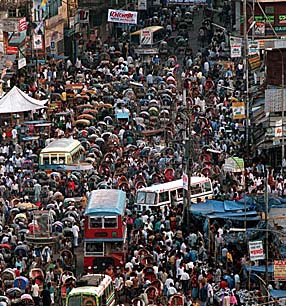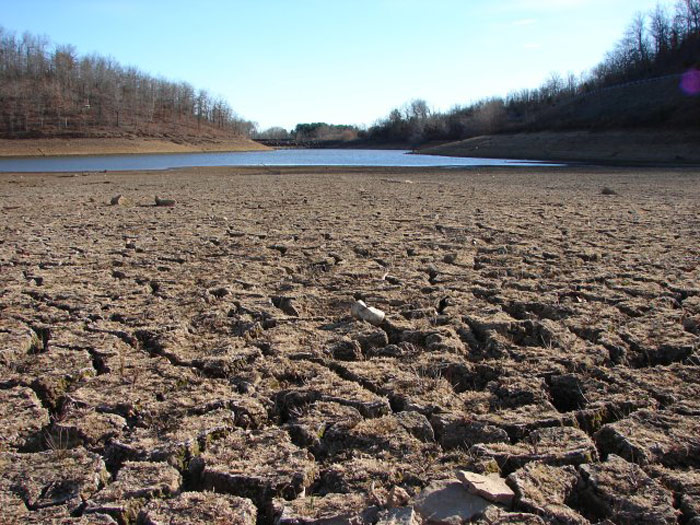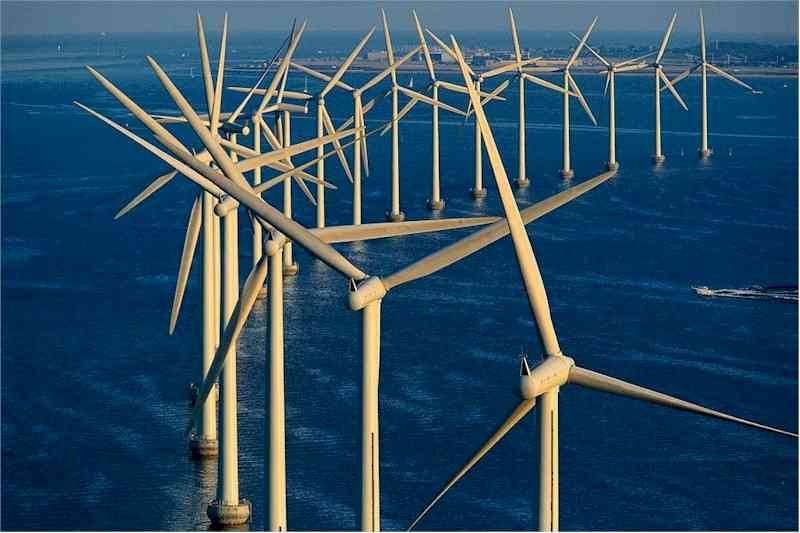Finding room for those displaced by climate change is an issue that is being viewed with greater and greater concern and India is one of the nations most worried about the possible influx of environmental migrants that they could experience, as rising sea levels threaten an increasing percentage of the densely populated, low-lying, coastal regions of Bangladesh (for more detail and statistics see previous post on
Buoyant Bangladesh with the link to a really good National Geographic article). The chair of the IPCC recently spoke to India's Military College of Telecommunications Engineering and said that "Our defence forces might find themselves........guarding our borders against climate refugees, as rising sea levels swamp low-lying areas [in Bangladesh], forcing millions of climate refugees across India's border". And so, perhaps, in direct reponse to this threat, India have started to construct a 6 ft high, 2500 mile long concrete and barbed wire barrier along the India, Bangladesh border. However, the question that so many are wanting to hear the answer to is, just how many climate refugees can we expect?
Well, only one person has ever tried to calculate the number of climate refugees. In 1995 a British academic, named Myers, predicted that there were 25 million climate refugees (in 1995), due most in part to the drought-stricken African nations, and that this figuire would only continue to swell until it reached 50 million by 2010 and then 200 million by 2050. Since 1995, no one has tried to improve on these estimates or actually conduct a detailed review into excatly how many climate refugees exist and so Myers' figuires have continued to feature in reports by the IPCC, the UK's Stern review of economics of climate change and the UNHCR, despite the fact that many greatly question the accuracy of them. So, why is is so hard to calculate the number of climate refugees that exist? Firstly, the definition of a climate refugee is often under much debate. As explained in a previous post,
Do developed countries have a moral obligation to help those displaced by climate change?, many believe that, technically, climate refugees should be classed as environmental migrants as they neither have the same rights as refugees or are fleeing from war or politcal instability; instead they are people who have been displaced by global climate change induced environmental disasters. Secondly, it is extremely hard, and many scientists are not prepared to stick their necks out and say so, to attribute events to climate change. For example the peak of the droughts in the Sahel, in 1973, lead to millions of people moving from the area and so did the Ethiopian drought of 1983-1984 which is estimated to have created 1.5 million refugees. Hurricane Katrina, of 2005, is believed to have created 300,000 permanent Amerian refugees and millions were displaced by the Pakistan floods last year. It is clear to see that these natural disasters have forced people to migrate but were these disasters induced by global climate change? This is slightly harder to prove but, as we gain a better understanding of the changes occuring it is becoming easier. Al Gore, famously, publically stated that human induced climate change was responsible for Hurricane Katrina and a few reports released this year, after the devasting flooding experienced across the globe which is attributed to an execptionally strong La Nina (which could be linked to the record high sea temperatures possibly provoked by global climate change) have started to publish links, with evidence, betw
een disasters and global climate change [see
Dealing with the aftermath of flooding for more detail on the reports published]. Finally, it is, often, difficult to discover the root cause of people's migration and although it cannot be denied that climate is frequently a contributing factor, whether or not climate alone causes people to migrate is different. Discovering whether or not climate is the root cause of migration is hard as this factor is normally shrouded by the clearly visible economic impacts that changes to the climate have. In Mongolia, for example, changes to climate led to the destruction of pasture land which had huge economic impacts on the local farmers and provoked them to move. Due to this they considered themselves as economic migrants when strickly speaking surely they are environmental migrants as the economic hardship experienced was provoked by changes to the climate. It can also work the other way around as, initially, the 1 million people in Mexico who were displaced, in the 1990's, by hurricanes and floods who first considered to be enviornmental migrants but after further analysis it was decided that they were in actual fact economic migrants as it was the economic crisis in Mexico that first provoked people to migrate and then this process was only accerlated by the hurricanes and floods. Myers intitally predicted large scale migration in India and China with 6 million environmental refugees in China, due to the expansion of the Gobi desert, but, a recent EU report concluded that it was, infact, the large scale development projects, like the Three Gorges Dam in China which has displaced 2 million, that has contributed the most to migration.
A recent review by the UNEP of several case studies concluded that, only, the 100 people from a coral atoll in Vanauta and 500 from an island in the Bering Strait, whose coastal villages were destroyed by waves, which had been intensified by the disapperance of sea ice, were actual climate refugees as they had to migrate inland for safety. Although this may prove that climate refugees are something more than a myth, it has fuelled further skeptism as 600 people compares rather badly with the 25 million Myers predicted and only strengths the arguement that climate refugees do not exist to the potentially catastrophic proportions predicted. Contributing to this belief is that fact that many don't think that climate changes necessarily lead to migration as migration is not the easiest thing to complete - especially when lacking the essential resources which are scarce during droughts and floods; two events that some view as being global climate change induced environmental disasters that provoke people to move. The Sahel area, over past decades, has been greatly affected by drought and so many have chosen to leave the area but latest figuires suggest that migration rates actually decreased during the worst droughts - this only supports the above belief held by some. Many of those who hold this view fear that global climate change will actually have the opposite effect and instead of forcing millions to migrate, it will remove the mobility of people and their ability to migrate to safer areas. Another agruement, against the existance of climate refugees, is the fact that perhaps people have always moved, and will continue to move as part of a stragegy to cope with the world's variable climate and take industry with them; thereby not moving becuase of a direct threat but because conditions are more ideal in another location. This starts to link in with something I started thinking about when I was revising the population module which is the impact that climate has on development and whether or not climate had a bigger impact on development when we started developing than it does to countries developing knowadays - but thats a topic for another post.
I can feel that I am starting to go slightly off track and if I continue this will probably go on for ever so I think will finish up pretty soon! From this, I think it is clear to see that it is extremely hard to calculate the actual number of climate refugees that exist, for the various reasons discussed, but perhaps even harder to prove that they don't exist. If this is true, is this a case of an environmental crisis provoking a population crisis or will the world community be able to cope, as the global population continues to grow, with less habitable land? Will the global community respond by increasing the rate of urbanisation as cities are likely to be more greatly protected? Of course there is also the debate of where those, especially the estimated 30 million displaced, by rising sea-levels, from the Bangladesh coast line, are suppose to go? Is it right that India are building a physical barrier to prevent migration from Bangladesh? Who should take responsibilty for these people who, some, consider to be the victims of the developed worlds unsustainable lifestyles? The questions surrounding this topic are endless and the answers highly debatable (as with anything even remotely linked to global climate chage, it seems). Where do I stand on this topic........ Well, I am still a bit unsure on some of the things but I think I agree that climate refugees/enviromental migrants exist but to what scale I am unsure. I think part of the problem is that many are not aware about this issue and those that are displaced by climate change as it is not something that makes headline news all the time and I, myself, only found out about some of the case studies I mentioned above as I went looking for them. The other influential factor is that, climatic push factors are often shrouded by the more visible, resulitng, economic factors and so it is increasingly hard to determine the root cause. I do think though that global climate change, a likely environmental crisis, has the potential to provoke a population crisis and that, maybe, an increase in urbanisation would be an initial response - especially by those living in countries threaten by sea-level rise where the inland cities offer safety. If this was to occur then I believe it would be accompanied by detrimental social impacts such as issues with living conditions and sanitation, unemployment and food and water shortages. India building a barrier to prevent illegal migration and the movement of cows was always going to be a controversial move and although it will not help remedy the problems Bangladesh is and will continue to face, India itself cannot cope with an influx of migrants. When I was in India I spent most of the time in Chennai, a city that is extremley densely populated, and if I am honest the thought of India's population exceeding that of China's before 2030 scares me as, already, only a tiny proportion have access to housing, sanitation, food, clean water, health care and education and shanty towns can be found in every direction you look and so at present, I feel that India cannot, without severly risking the already poor living standards of its population, help Bangladesh and its people on the scale needed. The idea of responsibilty is, with out a doubt, the one question that I am really struggling to make a decisive decision on and, after my last attempt at answering the question a few months ago, I am yet to make much progress on forming an opinion. Its tricky - especially when the effects that global climate change will have on all the different countries is still up for debate. Idealistically, I think that, if we view the world as being a global community then each country should do what it can to help out others which will mean that some countries will take more responsibilty than others but with the present state of global affairs and politics I think that this is, perhaps, slightly to far from reality and won't occur unless necessity demands it too or politicians, especially in the most powerful nations, start to fully appreciate the significance of their nations interdependcy on some many others. I don't think I would, at present, be able to whole-heartedly agrue my opinions as I still have a few reservations and so I will probably come back to this at some point after further thought and a bit more reading around the subject but I am very intrigued to know what you think about it.........


























